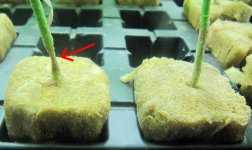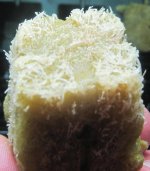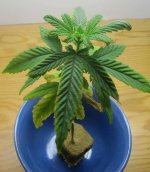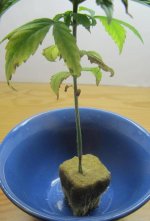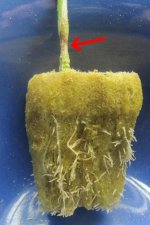Hi,
my plants are around six weeks old after they germinated from seed and are now in 1.5" rockwool cubes under a 55W 9000Lumen PL-L.
Humidity is between 40-50%, air temperature is between 24-27° C / 75 - 80 F. The surface of the leaves has the same temperature (measured with a laser thermometer) so not too close to the light.
I started to feed them just formulex 19 days ago. Gradually increasing nutrients from 1/4 dosage and I feed them now double the dosage.
They should be ready for proper nutrients as they have five or more real sets of leaves. Formulex is only NPK 2.4:0,9:3,4, so very mild and I didn't bought proper hydro nutrients yet which have three times the NPK usually.
Within the last week their stem started to thicken up a lot and I noticed a few days ago that 60% of my seedlings have some kind of bottleneck in their stem (pictures attached).
The stems are also in the process to shed a layer of transparent/purplish skin. I assume this is due to the stem growth? They used to have a purplish looking tiny stem before.
Furthermore two days ago three plants broke at their bottleneck as I shaked the rockwool cubes too much after watering to get excesss water out of them.
I attached these plants to a stick and they seem not to bother for now.
I was checking regarding the bottleneck thing and it appears to me that this is "damping off / fungus", can you confirm this please? If so is there a way to try get rid off it?
The roots of the plants are not bright white as they used to be but have a very, very light brown touch to them (see pictures). But they still look more white than brownish.
If this is "damping off" I am surprised how this could happen because I always let the rockwool cubes get nearly dried out before watering again.
I water them from the bottom by holding the lower half into water for max 2-3 seconds.
I used to have a humidity dome on for the first two weeks but removed it after I read it is no good for seedlings.
But the dome was never attached properly to the tray anyway so humidty could escape from the sides and not only the top.
Germination happened via the papertowel method.
Furthermore the lower smaller leaves of most of my plants start to yellow now (plants without bottleneck affected too) but the top leaves are looking good.
Is this because the top leaves are sucking out nutrient from the lower ones or do my plants have any deficiencies?
I also have to note that the lower leaves barely get any light as the plants got bushy and there is not much place for them.
Hence I will repot them into 4" rockwool cubes in the next days and move them to a larger area with more light.
After a couple of weeks in these 4" rockwool cubes I intend to move them in a ebb and flow system with 5 gallon buckets.
I hope you guys can help me out.
Please click on the thumbnails to see fullsize pictures:





my plants are around six weeks old after they germinated from seed and are now in 1.5" rockwool cubes under a 55W 9000Lumen PL-L.
Humidity is between 40-50%, air temperature is between 24-27° C / 75 - 80 F. The surface of the leaves has the same temperature (measured with a laser thermometer) so not too close to the light.
I started to feed them just formulex 19 days ago. Gradually increasing nutrients from 1/4 dosage and I feed them now double the dosage.
They should be ready for proper nutrients as they have five or more real sets of leaves. Formulex is only NPK 2.4:0,9:3,4, so very mild and I didn't bought proper hydro nutrients yet which have three times the NPK usually.
Within the last week their stem started to thicken up a lot and I noticed a few days ago that 60% of my seedlings have some kind of bottleneck in their stem (pictures attached).
The stems are also in the process to shed a layer of transparent/purplish skin. I assume this is due to the stem growth? They used to have a purplish looking tiny stem before.
Furthermore two days ago three plants broke at their bottleneck as I shaked the rockwool cubes too much after watering to get excesss water out of them.
I attached these plants to a stick and they seem not to bother for now.
I was checking regarding the bottleneck thing and it appears to me that this is "damping off / fungus", can you confirm this please? If so is there a way to try get rid off it?
The roots of the plants are not bright white as they used to be but have a very, very light brown touch to them (see pictures). But they still look more white than brownish.
If this is "damping off" I am surprised how this could happen because I always let the rockwool cubes get nearly dried out before watering again.
I water them from the bottom by holding the lower half into water for max 2-3 seconds.
I used to have a humidity dome on for the first two weeks but removed it after I read it is no good for seedlings.
But the dome was never attached properly to the tray anyway so humidty could escape from the sides and not only the top.
Germination happened via the papertowel method.
Furthermore the lower smaller leaves of most of my plants start to yellow now (plants without bottleneck affected too) but the top leaves are looking good.
Is this because the top leaves are sucking out nutrient from the lower ones or do my plants have any deficiencies?
I also have to note that the lower leaves barely get any light as the plants got bushy and there is not much place for them.
Hence I will repot them into 4" rockwool cubes in the next days and move them to a larger area with more light.
After a couple of weeks in these 4" rockwool cubes I intend to move them in a ebb and flow system with 5 gallon buckets.
I hope you guys can help me out.
Please click on the thumbnails to see fullsize pictures:






